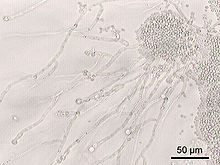Saccharomycotina
| Saccharomycotina | |
|---|---|

| |
| Candida albicans | |
| Scientific classification | |
| Domain: | Eukaryota |
| Kingdom: | Fungi |
| Division: | Ascomycota |
| (unranked): | Saccharomyceta |
| Subdivision: | Saccharomycotina O.E. Erikss. & Winka 1997[1] |
| Classes | |
| Synonyms | |
| |
Saccharomycotina is a subdivision (subphylum) of the division (phylum)
The subdivision includes a single class: Saccharomycetes, which again contains a single order: Saccharomycetales.[2][3]
Notable members of Saccharomycotina are the baker's yeast Saccharomyces cerevisiae and the genus Candida that includes several human pathogens.
Etymology
The name comes from the Greek word σάκχαρον (sákkharon), meaning "sugar" and μύκης (mukēs) meaning "fungus".
History and economic importance
Historical records from ancient Egypt and China describe the processes of brewing and baking from 10,000 to 8,000 years ago, and the production of
Saccharomycotina include some of the economically most important
Morphology
Saccharomycete yeasts usually grow as single cells. Their cellular morphology is fairly simple, although their growth form is highly adapted.
Some species (e.g.
Reproduction
Asexual reproduction
Asexual reproduction occurs mainly vegetatively by mitosis and budding. Saccharomycotina is characterized by holoblastic budding,[12] which means all layers of the parent cell wall are involved in the budding event. This leaves a scar through which no further budding occurs.
Asexual cells may vary in shape.[13] The shape of the cell may be informative in terms of detecting mode of reproduction or taxonomic placement to genera or species.
Although not commonly known, some species form endospores (e.g.
Sexual reproduction
In Saccharomycotina there are two
Distribution and ecology
Saccharomycete
Examples of ecological modes in Saccharomycotina:
- Associations with insects[14]
- Associations with plants, including Saccharomyces cerevisiae with grapes[15]
- Plant parasitism (e.g. cotton boll rot by Eremothecium ashbyi, Eremothecium gossypii as pathogen on coffee, soybean and other crops)[2]
- Saprotrophism on leaves and decaying wood (e.g. Ogataea)[16]
- Human pathogens (e.g. species of Candida and Meyerozyma)[8][9]
Although yeasts are commonly isolated from soil, few are believed to have soil as a primary habitat.[2]
Accurate identification of species is important for understanding yeast
Taxonomy
Saccharomycotina is a subdivision (subphylum) of the division (phylum) Ascomycota. It is a sister group to Pezizomycotina.[2][3]
In addition, the recent[
Molecular identification methods are important tools for discovery of new species and subsequently give better understanding of biodiversity in this group. Much of the future classification of Saccharomycotina will rest on phylogenetic analysis of DNA sequences rather than on the morphological and developmental characters.[citation needed]
Phylogeny
Phylogeny by Groenewald et al. 2023[19]
| Saccharomycotina |
| |||||||||||||||||||||||||||||||||||||||||||||||||||||||||||||||||||||||||||||||||||||||||||||||||||||||||||||||||||||||||||||||||
See also
References
- ^ Eriksson, O.E. & K. Winka (1997). "Supraordinal taxa of Ascomycota". Myconet. 1: 1–16.
- ^ ISBN 978-3-662-46010-8.)
{{cite book}}: CS1 maint: multiple names: authors list (link - ^ a b c Eriksson, O. E., and Winka, K (1997). "Supraordinal taxa of Ascomycota". Myconet.
{{cite journal}}: CS1 maint: multiple names: authors list (link) - ^ a b c d e f Moore. D., Robson, G.D., and Trinci, A. P. J. (2011). 21st Century Guidebook to Fungi (2nd ed.). Cambridge, UK: Cambridge University Press. pp. 200–202.
{{cite book}}: CS1 maint: multiple names: authors list (link) - OCLC 71834130.
- ^ Pasteur, L. (1858). "Nouveaux faits concernant l'histoire de la fermentation alcoolique". Annales de Chimie et de Physique. 3: 404–414.
- ^ Manchester, K.L. (2007). "Louis Pasteur, fermentation, and a rival". South African Journal of Science. 103 (9–10): 377–380.
- ^ S2CID 795450.)
{{cite journal}}: CS1 maint: multiple names: authors list (link - ^ S2CID 3098136.)
{{cite journal}}: CS1 maint: multiple names: authors list (link - ^ Martin, F. (2014). The Ecological Genomics of Fungi (1st ed.). USA: John Wiley & Sons, Inc.
- ^ a b Kurtzman, C., Fell, J. W., and Boekhout, T. (2011). The yeasts: a taxonomic study (5th ed.). Amsterdam, Netherlands: Elsevier.
{{cite book}}: CS1 maint: multiple names: authors list (link) - ^ von Arx, J.A., and van der Walt, J.P. (1987). Ophiostomatales and endomycetales. In: de Hoog GS, Smith MT, Weijman ACM (eds) The expanding realm of yeast-like fungi. Amsterdam, Netherlands: Elsevier.
{{cite book}}: CS1 maint: multiple names: authors list (link) - ^ Kirk, P.M., Cannon, P.F., Minter, D.W., Stalpers, J.A. (2008). Ainsworth & Bisby's dictionary of the fungi (10th ed.). Wallingford: CAB International.
{{cite book}}: CS1 maint: multiple names: authors list (link) - ^ Vega, F.E., and Blackwell, M. (2005). Insect–fungal associations: ecology and evolution. Oxford, UK: Oxford University Press.
{{cite book}}: CS1 maint: multiple names: authors list (link) - PMID 10229949.)
{{cite journal}}: CS1 maint: multiple names: authors list (link - ^ de Koning, W., and Harder, W. (1992). Methanol-utilizing yeasts. In: Murell JC, Dalton H (eds) Methane and methanol utilizers. New York, USA: Plenum. pp. 207–244.
{{cite book}}: CS1 maint: multiple names: authors list (link) - ^ McNeill, J.; et al. (2012). "International Code of Nomenclature for algae, fungi and plants". Regnum Vegetabile. 154.
- ^ PMID 22679600.
- .
